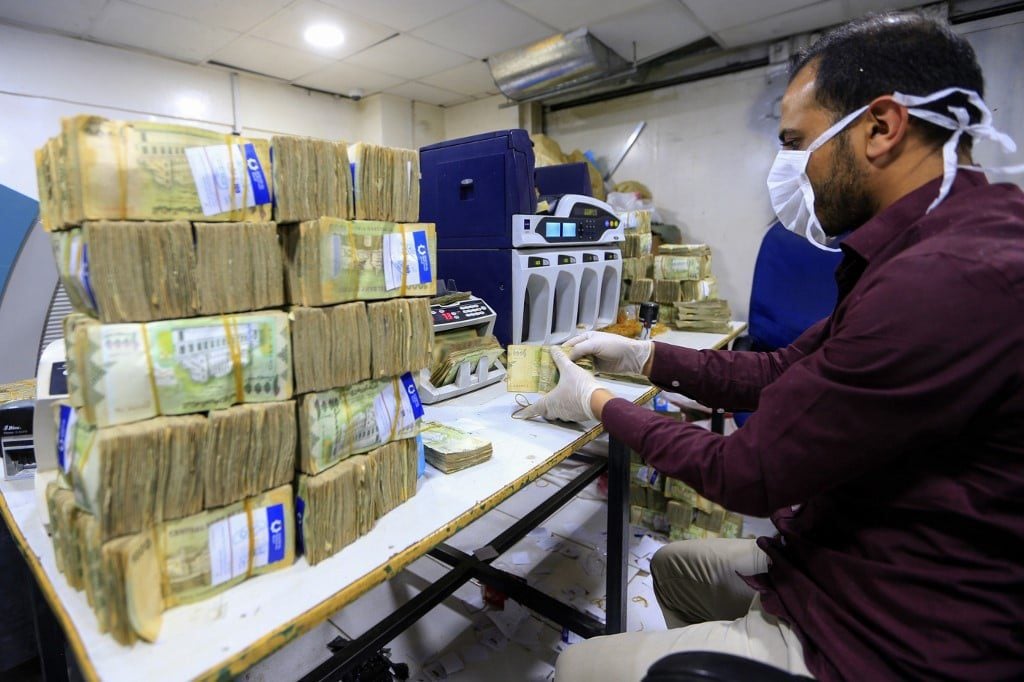
Adel Mojahed
During the past 5 years, the Yemeni currency lost more than 300% of its value. Compared to an exchange rate of 215 Riyals per dollar in 2015, the current exchange rate of the US Dollar is close to 900 Yemeni Riyals in the territories controlled by the “legitimate authority” headed by Abdrabbuh Mansour Hadi. According to economic experts, the Yemeni Riyal might even lose about 46% of its value by the end of this year.
Yemen is considered among the poorest countries of the Middle East & North Africa region. The UN classified it as one of the least growing countries in the world.
Depending mainly on a rentier economy and international aids, Yemen lacks oil resources. The country historically suffers from structural issues. That includes corruption, sovereignty of tribal loyalties and local conflicts. Such a dilemma applies to the territories controlled either by the “legitimate government” and its allies, or by the Houthis since September 2014.
As a result of the ongoing conflict between the two parties, the country’s GDP (Constant LCU) recorded a 38% decrease between 2014 and 2018. According to the World Bank, 27.6% of this loss was particularly recorded in 2015. That was the same year in which a Gulf alliance headed by KSA launched the two military operations “Decisive Storm” and “Restoring Hope”. The aim of these campaigns was to stop the advance of the Houthi rebels towards “Aden” in the south.
The exchange rate of the Yemeni Riyal decreased as a consequence of the continuous military operations. The situation worsened due to the central banking division after the Houthis took over the Central Bank of Yemen in the capital Sana’a (September 2016). Consequently, both parties lost their control over local currency exchange rates. Semi-simultaneous decisions have been taken to float the local currency, making it a subject to supply and demand.
Inflation rates noticeably varied between the regions controlled by each party. In fact, this affected the Yemenis who already used to live in dire circumstances worsening daily due to the increasing economic crises. International organizations described the situation as “devastating”, having two Riyals with two different values: a legitimate Riyal and a rebel one.
Consequently, the cumulative inflation rate during the last 5 years reached 180% in Sana’a and in the regions where Houthi rebels are stationed. In Aden and the regions controlled by the legitimate government and its allies, inflation passed 300%.
In the northern territories of Yemen, Houthis reinjected billions of damaged and mutilated currency bills to be exchanged again. The former government previously blocked these bills as they were supposed to be shredded later. Moreover, the Houthis reinjected again billions of 200 and 50 Riyal bills. These bills were retrieved years ago and were exchanged with new 250 Riyal bills. This caused inflation rates to rise in regions controlled by the Houthis. Moreover, the Riyal exchange rate decreased.
On the other side, the authority in Aden printed and issued currency bills of different values in two models. One of these models is identical to the one circulated. The other one is a new different model of 100, 250, 500 and 1000 Riyal bills, with no cash cover or services and commodities.
It is noteworthy to know that the Houthis controlling Sana’a banned possession or exchange of the new Yemeni Riyal and all its different bills starting by January 2020.
The Saudi 2 billion USD deposit, acquired by the Yemeni Central Bank in Aden (March, 2018), couldn’t put a stop to the decreasing Riyal exchange rate in regions controlled by its allies. Furthermore, it could not restrict the rising inflation. The deposit was directed to support petroleum products and basic commodities importers, with favored prices ranging between 440 and 500 Riyals for each 1 USD. This price is 30% less than the market price. That came along with a severe shortage of foreign exchange reserves, in addition to a decrease in expatriate remittances, especially in Saudi Arabia. The shortage is due to the slowdown of the economic activity of a country that hosts a huge number of Yemeni workers.
Between the two Riyals; namely the “legitimate” Riyal and the Houthi Riyal, and the huge variance of inflation rates between the two regions, Yemenis’ bones are crushed all over Yemen. They are obviously shredded by territorial and local forces, in addition to being juggled between two economies.
DISCLAIMER
The opinions expressed in this publication are those of our bloggers. They do not purport to reflect the opinions or views of Fanack or its Board of Editors.


